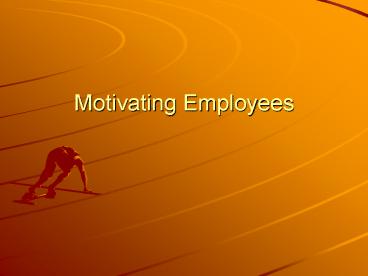Motivating Employees - PowerPoint PPT Presentation
1 / 35
Title:
Motivating Employees
Description:
Motivating Employees Motivating Employees Our Motivating Tips Major Motivational Theories There are three major motivational theories that are observed in modern ... – PowerPoint PPT presentation
Number of Views:314
Avg rating:3.0/5.0
Title: Motivating Employees
1
Motivating Employees
2
Motivating Employees
- Our Motivating Tips
3
Major Motivational Theories
- There are three major motivational theories that
are observed in modern business - McGregors X/Y Theory and Group Exercise
- Maslows Hierarchy of Needs and Exercise
- Herzbergs Theory and Group Discussion
4
McGregors X/Y Theory
- An American social psychologist, Douglas
McGregor, proposed his famous X-Y theory in his
1960 book 'The Human Side Of Enterprise'. - McGregor's X-Y Theory remains a valid basic
principle from which to develop positive
management style and techniques.
5
Theory X
- Theory X has these basic premises
- Most people are naturally lazy and dont like to
work - Most people lack ambition and need a club over
their heads in order to make them work - Most people prefer to be told what to do, and
they avoid responsibility - Most people resist change
- Most people are gullible and not overly
intelligent - Most people are motivated by money and status
rewards
6
Theory Y
- Theory Y has these basic premises
- People do not dislike work, and may actively seek
it - People do not need authoritarian leadership and
prefer a participative kind of management - People prefer setting their own goals rather than
have someone else set them - People do not shirk responsibility but rather
seek it - People who understand and care about what they
are doing can devise and improve their own
methods of doing work - People constantly grow and are motivated at work
by interesting and challenging tasks.
7
- What is most important to understand about these
two theories are that they relate to how managers
picture their employees not how the employees
really are.
8
(No Transcript)
9
Maslow
- Maslows hierarchy of needs
- Physiological needs
- The basic drives, including the need for food,
rest and shelter - Safety and Security needs
- Freedom from fear, danger, uncertainty about
employment - Social needs
- Friendly work relationships in harmonious
atmosphere
10
- Esteem and self respect
- Ego or status needs, praise for a job well done
- Self-realization
- The need for self-fulfullment, creativity
11
(No Transcript)
12
Herzbergs Motivation Theory
- Achievement
- Opportunity for accomplishment and contribution
- Recognition
- Acknowledgement and appreciation for
contributions - Responsibility
- Acquisition of new duties and responsibilities
13
- Advancement
- Opportunity to advance as a result of job
performance - The Work itself
- Opportunity for self-expression, personal
satisfaction and challenge - Possibility of growth
- Opportunity to increase knowledge and develop
through job experiences
14
(No Transcript)
15
(No Transcript)
16
Exercise
- Managers Dilemma 1
17
Exercise
- Managers Dilemma 2
18
Exercise
- Job Factors Survey
19
Dealing with Problem or Marginal Employees
- Describe the problem or poor work habit in a
friendly manner. - Indicate why it is a concern
- Invite the employee to share his or her side of
the story - Show interest in what he or she is saying through
proactive listening - Focus on the changes you want from the employee
- Not the complaints you might have had about their
performance
20
- Avoid threats and punishments as a means to
improve behavior - Ask the employee for their ideas and solutions to
solve the problem - Ask the employee to consider the positive
consequences of improving his or her actions - Self, the organization, other workers, etc.
- Agree on a performance-change objective and a
plan of action. Offer your help.
21
Exercise
- Action Plan
22
- Handout Sheets
23
(No Transcript)
24
(No Transcript)
25
(No Transcript)
26
(No Transcript)
27
(No Transcript)
28
(No Transcript)
29
(No Transcript)
30
(No Transcript)
31
(No Transcript)
32
(No Transcript)
33
(No Transcript)
34
(No Transcript)
35
(No Transcript)































